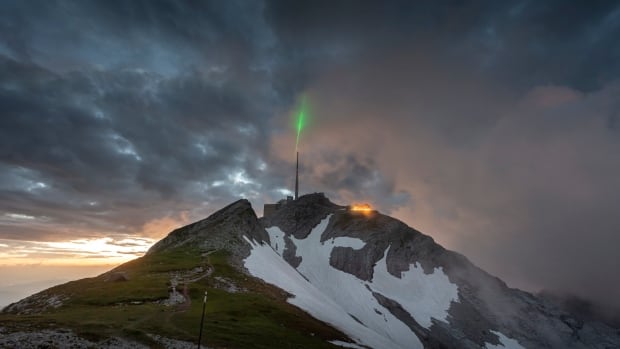As It Happens6:43Scientists divert lightning with a great big laser
Decades of playing with lightning have finally paid off for Jean-Pierre Wolf and his colleagues.
The University of Geneva physicist and his team have accomplished something nobody has before — diverting the path of lightning by shooting a massive laser at the sky.
“That was an incredible moment,” Wolf told As It Happens host Nil Köksal, describing the first time he saw their laser successfully intercept a bolt of lightning atop a Swiss mountain on a stormy day. “I couldn’t really believe that it finally worked.”
The technology is still in its very early stages, but once perfected, it could one day be used to protect large-scale infrastructure — such as airports or rocket launch pads — from lightning’s dangerous and unpredictable strikes.
Wolf and his colleagues describe the project in a study published this week in the journal Nature Photonics.
The ‘wow moment’
Scientists have used lasers to control lightning before, but only in laboratories. This experiment was the first time it’s been demonstrated in a real-world setting.
Wolf’s team installed the laser atop Säntis — a mountain in northeastern Switzerland — next to a telecommunications tower topped with a lightning rod that gets struck about 100 times a year.
During six hours of thunderstorms between July and September 2021, they blasted the laser some 150 metres into the sky, just above the 124-metre tower, sending bursts of infrared light at a rate of about 1,000 times per second.
On four occasions, the laser successfully intersected the lightning and diverted it toward the lightning rod. One of those instances, the weather was clear enough that two high-speed cameras monitoring the site captured the moment a lightning bolt followed the path of the laser for about 50 metres.
Wolf called it a “wow” moment.
Shout-out to Benjamin Franklin
While the concept of a lightning laser screams 21st century, Wolf says that at its core, it’s really just an update to a 270-year-old invention.
For hundreds of years, lightning rods — the brainchild of 18th-century scientist Benjamin Franklin — use metal conductivity to lure lightning away from homes and buildings.
“When the lightning comes down, suddenly it sees … this stick, which is metallic and then conductive, and then the electricity likes that. So it’s a preferred path,” Wolf said.
The laser, Wolf says, operates on a similar principle.
“The laser, roughly said, is making the air conductive,” Wolf said. “So the trick is that instead of installing a metallic stick, we use a laser and transform the air, isolating it into a conductor.”

Lightning rods remain incredibly effective, Wolf said, but their application is limited. That’s because a rod’s protection is directly proportional to its height. A 20-metre rod, for example, protects everything within a 20-metre radius.
“That’s perfect for your house, for instance,” Wolf said.
But when it comes to large infrastructure — say, an airport, or an electrical power plant — a lightning rod is no longer practical. That’s when a laser becomes more useful. In theory, it could protect areas hundreds of metres wide at a time, if there’s enough energy to power it.
“The idea with the laser is the extension of the concept of Benjamin Franklin by making … a virtual lightning rod along the laser path, which can be, in principle, as long as you want,” Wolf said.
Miles to go
But four successfully diverted bolts doesn’t mean the laser is ready to roll out for widespread. Wolf says this is just the beginning, and the research will continue.
“You have this phase, this no man’s land, basically between the discovery and the product. And I wouldn’t say it’s easy to be funded for basic research, but it’s definitely much easier to be funded for basic research than to be funded for this no man’s land.” he said.
“What we will need now is not only to demonstrate that it works, but to optimize the process.”


